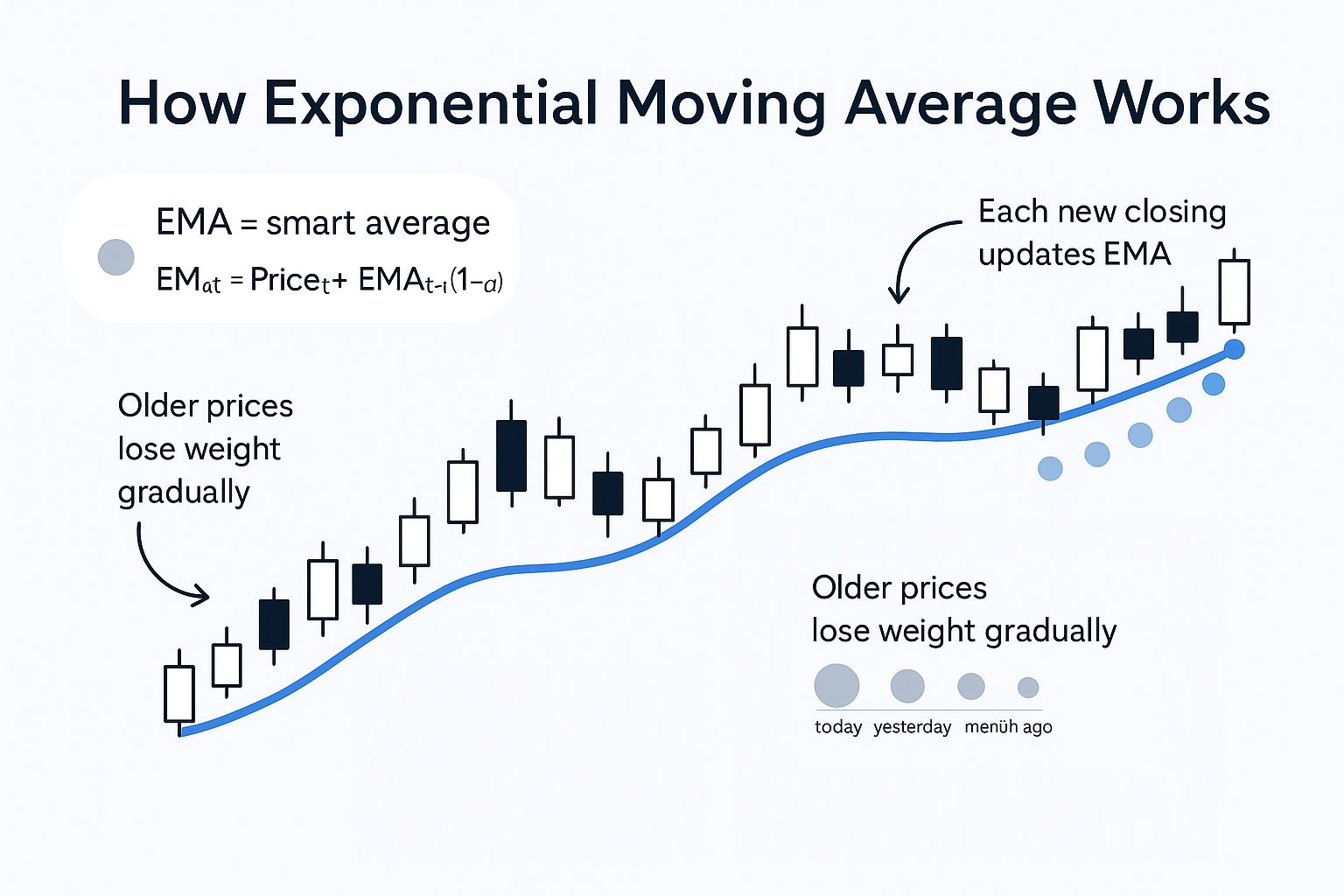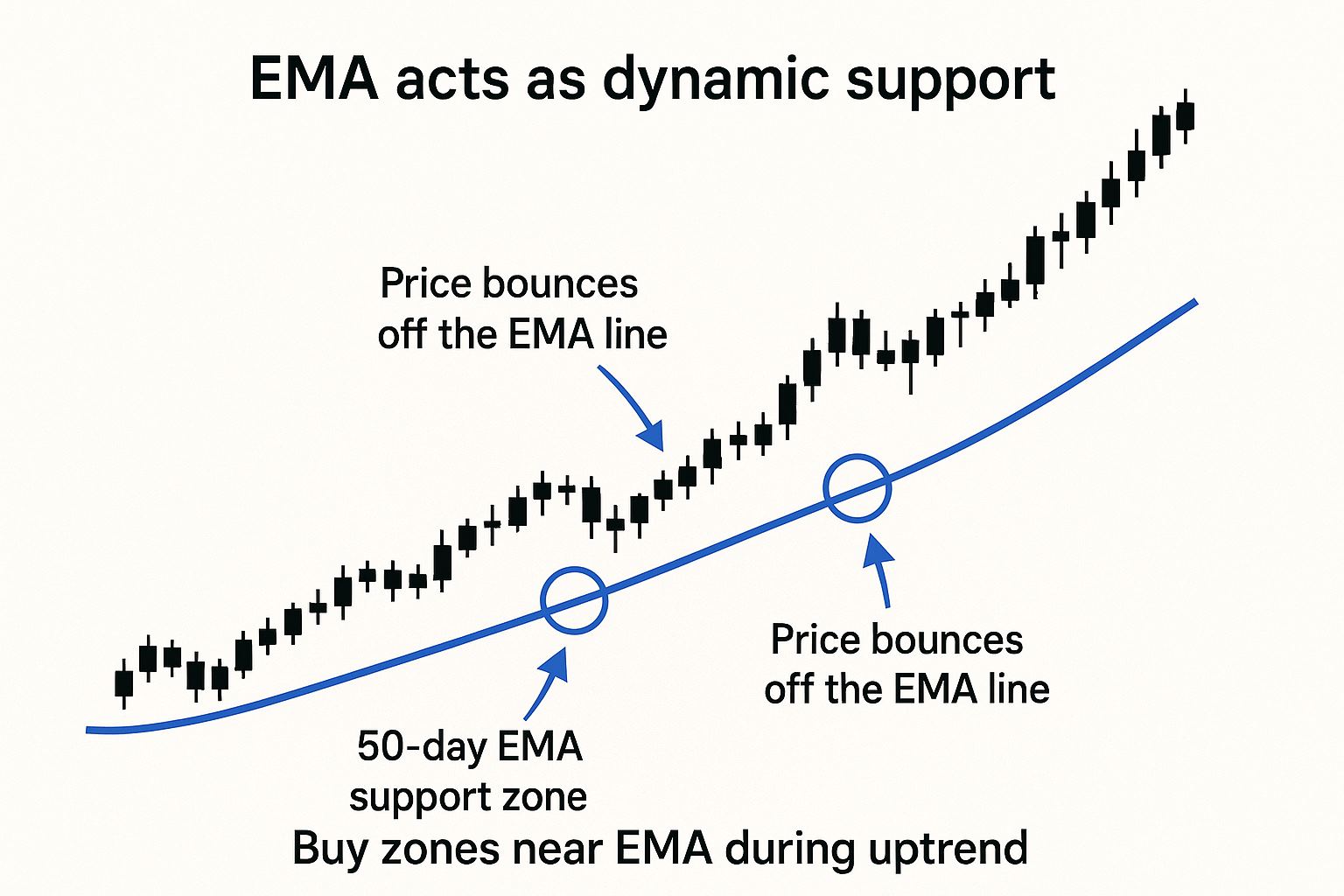A EMA é um indicador técnico que acompanha o preço das ações ao longo do tempo. É um dos indicadores de atraso mais populares no trading. Ao contrário dos cálculos simples da média móvel, a EMA enfatiza a atividade recente do dia de negociação.
Pense na EMA como um assistente inteligente. Ela lembra os preços passados, mas presta mais atenção ao que aconteceu ontem. Este indicador técnico do gráfico suaviza as flutuações de preço, mantendo-se atualizado. Os negociadores confiam nele porque os mercados se movem rapidamente.
A EMA dá maior peso aos dados recentes. Se uma ação subiu 5% hoje, a EMA percebe imediatamente. Uma média móvel simples (SMA) trata todos os dias igualmente. Essa diferença é importante quando você precisa de sinais rápidos.
Os traders profissionais utilizam médias móveis exponenciais para vários intervalos de tempo. Uma EMA de 12 dias acompanha os movimentos de curto prazo. Uma EMA de 26 dias capta as tendências de médio prazo. A EMA de 200 dias mostra a direção de longo prazo. Cada uma tem uma finalidade específica na análise.
A maioria das plataformas de negociação exibe a EMA como uma linha azul nos gráficos. Ela flui através das barras de preços como um rio. Quando os preços permanecem acima da EMA, isso sugere força. Preços abaixo dela geralmente sinalizam fraqueza. Essa simplicidade visual torna a EMA acessível para iniciantes.
COMO FUNCIONA A MÉDIA MÓVEL EXPONENCIAL (EMA)
)
A média móvel exponencial funciona aplicando um multiplicador aos dados recentes. Esse multiplicador garante que os novos movimentos de preços influenciem a média mais do que os dados médios históricos. O cálculo cria uma linha suave que acompanha de perto as flutuações de preços.
Eis a magia: a EMA ajusta-se constantemente. Cada novo preço de fecho atualiza todo o cálculo. Os pontos de dados mais antigos desaparecem gradualmente, mas nunca desaparecem completamente. Isto cria um indicador responsivo, mas estável.
O processo de ponderação distingue a EMA de outros indicadores de média móvel. Os dados recentes de preços podem representar 20% do cálculo total. Os dados de ontem recebem um peso ligeiramente menor. Os preços da semana passada têm ainda menos importância. Esse decaimento exponencial dá nome ao indicador.
QUAL É A IMPORTÂNCIA DA MÉDIA MÓVEL EXPONENCIAL (EMA) NA ANÁLISE TÉCNICA?
A EMA gera sinais de compra e venda fiáveis para os negociadores intradiários. Quando o preço ultrapassa uma EMA em ascensão, isso geralmente sinaliza uma oportunidade de compra. O oposto sugere a venda. Esses cruzamentos ajudam os negociadores a sincronizar as suas posições de negociação de forma eficaz.
A análise técnica depende fortemente da EMA para confirmar tendências. Uma EMA em alta confirma o impulso ascendente. Uma EMA em queda valida a pressão descendente. Os traders combinam várias EMAs para identificar mudanças de tendência antecipadamente.
O indicador é excelente para filtrar o ruído do mercado. As oscilações diárias dos preços podem confundir os traders. A EMA suaviza esses movimentos, transformando-os em padrões claros. Essa clareza ajuda tanto os iniciantes quanto os profissionais a tomar melhores decisões com base na ação dos preços.
FÓRMULA PARA A MÉDIA MÓVEL EXPONENCIAL (EMA)
A fórmula da EMA combina três elementos: o preço de hoje, a EMA de ontem e um multiplicador. Compreender esta fórmula ajuda os traders a personalizar a sua análise. Aqui está a estrutura básica:
EMA = (Preço atual × Multiplicador) + (EMA anterior × (1 - Multiplicador))
O multiplicador determina a ponderação da EMA para pontos de dados recentes.
Calcule-o usando esta fórmula:
Multiplicador = 2 ÷ (Período de tempo + 1)
Para uma EMA de 10 dias, o multiplicador é igual a 2 ÷ 11 = 0,1818 (18,18%). Isto significa que o preço de hoje contribui com 18,18% para o valor final. Os restantes 81,82% provêm de cálculos anteriores.
A fórmula cria um alisamento exponencial. Cada cálculo baseia-se no anterior. Esta natureza recursiva torna a EMA responsiva, mas estável. Os picos repentinos de preços afetam-na menos do que os indicadores de média móvel simples.
Não se preocupe se a matemática não for o seu forte. As plataformas de negociação calculam a EMA automaticamente. Compreender o conceito é mais importante do que o cálculo manual. Concentre-se em interpretar os resultados, em vez de analisar números.
COMO CALCULAR A EMA?
O cálculo da média móvel exponencial envolve três etapas principais. Primeiro, calcule a média móvel simples (SMA) para o seu valor EMA inicial. Segundo, calcule o multiplicador. Terceiro, aplique a fórmula EMA para cada dia subsequente.
Etapa 1: Calcule a SMA inicial Some os preços de fechamento do período escolhido. Divida pelo número de dias. Para um período de 10 dias com preços que somam US$ 500, SMA = US$ 500 ÷ 10 = US$ 50.
Etapa 2: Calcule o multiplicador Use a fórmula: 2 ÷ (Período + 1). Para 10 dias: 2 ÷ 11 = 0,1818.
Passo 3: Aplique a fórmula EMA EMA atual diária = (Preço de hoje × 0,1818) + (EMA de ontem × 0,8182).
Digamos que o preço de hoje seja 52 dólares e que a EMA de ontem tenha sido 50 dólares:
- Nova EMA = (52 $ × 0,1818) + (50 $ × 0,8182)
- Nova EMA = $9,45 + $40,91 = $50,36
Qual é um exemplo de cálculo da média móvel exponencial (EMA) de 200 dias?
A média móvel exponencial de 200 dias acompanha as tendências de longo prazo. O seu multiplicador é igual a 2 ÷ 201 = 0,00995 (cerca de 1%). Este pequeno multiplicador torna-a estável e de movimento lento.
Imagine acompanhar as ações da Apple ao longo de 200 dias. Os preços iniciais têm uma média de 150 $. O preço de hoje salta para 160 $. O cálculo torna-se:
- Nova MME = (US$ 160 × 0,00995) + (US$ 150 × 0,99005)
- Nova EMA = US$ 1,59 + US$ 148,51 = US$ 150,10
Observe como o salto de 10 pontos mal alterou a EMA. Essa estabilidade ajuda a identificar grandes mudanças de tendência. Quando os preços finalmente empurram a EMA de 200 dias para cima, isso sinaliza um forte impulso.
Qual é um exemplo de cálculo da média móvel exponencial (EMA) de 50 dias?
A EMA de 50 dias equilibra a capacidade de resposta com a estabilidade. O seu multiplicador é 2 ÷ 51 = 0,0392 (3,92%). Este indicador de médio prazo capta as tendências intermédias de forma eficaz.
Usando o mesmo exemplo com média de US$ 150 e preço atual de US$ 160:
- Nova EMA = ($160 × 0,0392) + ($150 × 0,9608)
- Nova EMA = $6,27 + $144,12 = $150,39
A MME de 50 dias moveu-se mais do que a versão de 200 dias. No entanto, permanece estável o suficiente para filtrar o ruído diário. Muitos traders combinam ambas para uma análise abrangente.
APLICAÇÕES DA MÉDIA MÓVEL EXPONENCIAL
As médias móveis exponenciais têm várias finalidades na negociação. Investidores inteligentes usam-nas como ferramentas dinâmicas, em vez de linhas estáticas. Compreender essas aplicações melhora significativamente a sua análise técnica.
1. Destacando tendências
A EMA é excelente para revelar direções e tendências de preços. Uma tendência ascendente mostra preços consistentemente mais altos ao longo do tempo. A linha EMA inclina-se para cima, confirmando o momentum de alta. Os traders compram quando os preços permanecem acima das EMAs em ascensão.
Observe como a EMA responde durante as tendências. Em tendências de alta fortes, os preços raramente tocam a EMA. Eles ricocheteiam nela como um trampolim. Esse comportamento confirma a força da tendência e ajuda os traders a manterem-se posicionados corretamente.
Várias EMAs criam indicadores de tendência poderosos. A EMA de 20 dias mostra a direção de curto prazo. A de 50 dias revela tendências intermediárias. Juntas, elas traçam um quadro completo do movimento do mercado. Quando todas as EMAs se alinham para cima, as tendências são mais fortes.
2. Bandas de suporte e resistência
)
)
As EMAs criam níveis dinâmicos de suporte e resistência por meio da ação dos preços. Ao contrário das linhas horizontais fixas, esses níveis se movem com o mercado. Essa adaptabilidade os torna inestimáveis para os traders ativos.
Durante as tendências de alta, as EMAs atuam como suporte. Os preços costumam rebater nelas antes de continuarem a subir. Os traders colocam ordens de compra perto desses níveis. A EMA de 50 dias oferece um suporte particularmente forte em mercados com tendência.
Em tendências de queda, as EMAs tornam-se resistência. Os preços têm dificuldade em ultrapassá-las. Os vendedores a descoberto utilizam esses níveis para entrar em posições. A EMA de 200 dias costuma atuar como resistência importante durante mercados em baixa.
Esses níveis de suporte e resistência fortalecem-se com os testes. Cada recuperação bem-sucedida reforça a importância do nível. Os traders ganham confiança quando as EMAs se mantêm repetidamente. Romper esses níveis sinaliza possíveis mudanças de tendência.
QUAIS SÃO AS VANTAGENS DA EMA?
A média móvel exponencial oferece vários benefícios para acompanhar as flutuações de preços nas negociações intradiárias. Compreender essas vantagens ajuda a usar a EMA de forma eficaz em diferentes tendências de mercado e prazos.
- Resposta rápida às alterações de preço A EMA reage mais rapidamente às movimentações recentes dos preços do que as médias simples. Essa capacidade de resposta, devido ao maior peso atribuído aos dados recentes, ajuda os traders a identificar tendências antecipadamente. Poderá identificar oportunidades antes que os indicadores mais lentos sinalizem. Reações rápidas são importantes em mercados voláteis.
- Identificação suave de tendências Apesar da sua capacidade de resposta, a EMA mantém curvas suaves. Ela filtra pequenas flutuações, preservando movimentos importantes. Esse equilíbrio ajuda a identificar tendências genuínas em comparação com picos temporários. Sinais claros reduzem negociações falsas.
- Versatilidade em todos os intervalos de tempo A EMA funciona eficazmente em qualquer período do gráfico. Os scalpers utilizam EMAs de 5 minutos para negociações rápidas. Os swing traders preferem EMAs diárias. Os investidores de longo prazo observam as versões semanais. Um único indicador serve todos os estilos de negociação.
- Interpretação visual fácil A EMA cria sinais visuais claros nos gráficos. Os cruzamentos são óbvios. As direções das tendências aparecem instantaneamente. O suporte e a resistência são mostrados claramente. Essa simplicidade ajuda os iniciantes a aprender rapidamente, ao mesmo tempo que oferece profundidade para os especialistas.
QUAIS SÃO AS DESVANTAGENS DA EMA?
Apesar da sua popularidade, a média móvel exponencial tem limitações. Estas desvantagens podem gerar sinais contraditórios durante determinadas condições de mercado. Compreender estas fraquezas evita erros dispendiosos nas suas sessões de negociação.
- Natureza do indicador atrasado A EMA continua a ser um indicador atrasado, apesar da sua capacidade de resposta. Não consegue prever preços futuros. Os sinais chegam depois de os movimentos terem começado. Este atraso causa entradas tardias durante reversões acentuadas. Os traders devem aceitar esta limitação inerente.
- Oscilações em mercados variáveis Os mercados laterais criam múltiplos sinais falsos. Os preços cruzam as EMAs repetidamente sem estabelecer tendências. Estas oscilações geram perdas para as estratégias que seguem tendências. As diferenças de preço agravam o problema durante a época de divulgação de resultados.
- Risco de dependência excessiva Alguns traders dependem excessivamente apenas da EMA. Nenhum indicador isolado fornece uma análise completa. As EMAs ignoram fatores importantes, como volume e momentum. Lembre-se: «A EMA é uma bússola, não um GPS» — ela mostra a direção, mas não navega em todas as curvas. Para ter sucesso nas negociações, é necessário usar várias ferramentas de confirmação além das médias móveis.
CONCLUSÃO
A média móvel exponencial (EMA) é uma ferramenta essencial para os traders modernos. A sua capacidade de enfatizar os preços recentes, mantendo o contexto histórico, cria um valor analítico único. Os traders inteligentes combinam a EMA com outros indicadores técnicos para uma análise abrangente do mercado.
O sucesso com a EMA requer prática e paciência. Comece com períodos mais longos para compreender os conceitos básicos. Passe para intervalos mais curtos à medida que as suas competências se desenvolvem. Lembre-se de que a EMA funciona melhor quando a ação do preço mostra mercados com tendências claras. Combine-a com indicadores de momentum durante os intervalos.
O indicador de convergência/divergência da média móvel (MACD) utiliza, na verdade, duas EMAs no seu cálculo. Este popular oscilador de momentum demonstra como as EMAs trabalham em conjunto para gerar sinais poderosos. Compreender as EMAs individuais ajuda-o a dominar indicadores mais complexos. Mais importante ainda, utilize a EMA como parte de uma estratégia de negociação completa. Deixe que ela guie as suas decisões, sem as ditar. A média móvel ponderada exponencialmente fornece insights, não garantias. Respeite os seus sinais, mantendo uma gestão de risco disciplinada. Considere primeiro negociar no papel para ganhar confiança com as condições reais do mercado.
Pronto para aplicar a EMA em negociações reais? Abra uma conta demo e pratique a identificação de tendências. Observe como diferentes EMAs interagem com os movimentos dos preços. A sua compreensão se aprofundará através da experiência prática. O mercado recompensa aqueles que dominam as suas ferramentas.
PERGUNTAS FREQUENTES
A EMA é melhor do que a SMA no day trading?
A EMA normalmente supera a média móvel simples (SMA) para negociações diárias devido aos tempos de resposta mais rápidos. Ela capta mudanças de momentum mais cedo, dando aos negociadores uma vantagem. No entanto, essa sensibilidade pode criar mais sinais falsos em mercados instáveis.
O que é uma boa média móvel exponencial?
A melhor média móvel exponencial depende do seu estilo de negociação e do seu horizonte temporal. As opções mais populares incluem 9 dias para curto prazo, 21 dias para swing trading e 50 dias para position trading. Teste diferentes períodos para descobrir o que se adequa melhor à sua estratégia.
Quais são os períodos de tempo mais utilizados para as EMAs?
Os períodos de tempo comuns para EMAs incluem 12 e 26 dias para cálculos MACD, 50 dias para tendências intermédias e 200 dias para análises de longo prazo. Os negociadores intradiários costumam usar EMAs de 5, 10 e 20 períodos em gráficos de minutos.
A EMA é igual à EWMA?
Sim, EMA e média móvel ponderada exponencialmente (EWMA) referem-se ao mesmo conceito. Ambos os termos descrevem o mesmo cálculo matemático que pondera mais fortemente os dados recentes. Os mercados financeiros preferem "EMA", enquanto os estatísticos usam "EWMA".
Como se lê as médias móveis exponenciais?
Leia as médias móveis exponenciais observando a sua inclinação e relação com o preço. EMAs em alta sinalizam tendências de alta, enquanto EMAs em queda indicam tendências de baixa. O preço a cruzar acima da EMA sugere oportunidades de compra, enquanto o cruzamento abaixo sugere pontos de venda.

